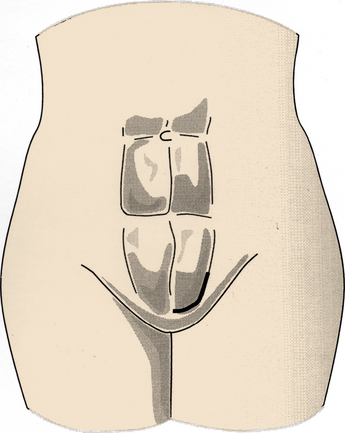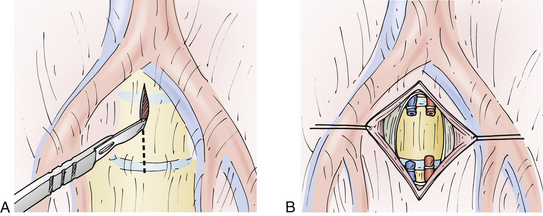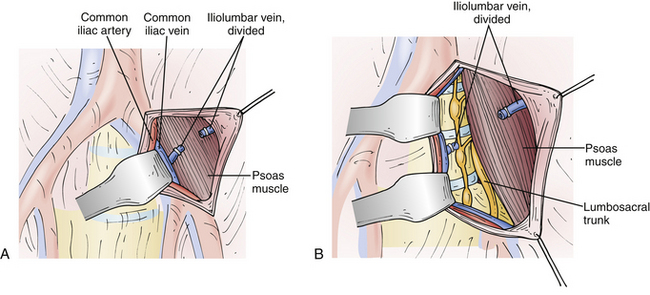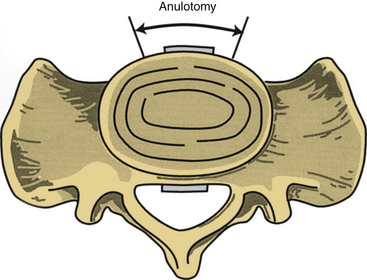Chapter 55 Anterior Lumbar Interbody Fusion
Possibly more than any other spinal surgical procedure, a careful consideration of the indications for ALIF is essential for a good surgical outcome. Chronic low back pain is a frequent indication for ALIF.1–10 ALIFs are not ordinarily used to decompress the neural elements because of less-than-optimal visualization. Therefore, safe ventral decompression is difficult to perform.1,11,12
History
Anterior lumbar interbody fusion has evolved considerably over the past century. Ventral approaches to the lumbar spine were first reported for the treatment of tuberculosis. In 1892, Vincent13 described a costotransversectomy that was used to treat tuberculosis of the ventral lumbar spine. In 1906, Muller14 described a transperitoneal decompressive operation for the lumbar spine. Ito et al.,15 in 1934, described a transperitoneal approach to the lumbar spine that incorporated fusion.
Spondylolisthesis has been treated with ventral lumbar surgery since 1933. At that time, Burns described a transperitoneal approach using a tibial graft for fusion of the L5-S1 interspace.16 Numerous other investigators have followed with modifications of ventral lumbar surgery for spondylolisthesis.17–26 The retroperitoneal approach to the lumbar spine was first reported by Iwahara27 in 1944. In 1948, Lane and Moore28 described a series of patients with isolated lumbar disc disease who were treated with ALIF.
Preoperative Considerations
Proper patient selection is vital to the success of an ALIF procedure12 and is the best predictor of a good surgical outcome. Operative indications for ALIF include degenerative disc disease with intractable back pain.2,6,9,10,29,30 Degenerative spondylolisthesis with back pain often accompanies degenerative disc disease.4,30–36 A failure of prior dorsal surgery may also be an indication for ALIF.1,2,7–9,11,12,31–33,37,38 Most important, the symptoms should have persisted for a prolonged period. In general, symptoms are present for 6 months or more before a patient undergoes ALIF. Likewise, a prolonged trial of conservative therapy should have been attempted and failed before planning an ALIF procedure.6,29,38,39 Contraindications to ALIF are absolute or relative. The only true absolute contraindication is advanced osteoporosis that prevents the vertebral bodies from maintaining a bone graft.1 Relative contraindications occur in varying degrees. Neural compression as a result of either disc disease or stenosis is a relative contraindication. If neural compression is present, it is most safely and thoroughly approached from a dorsal approach. Other relative contraindications to ALIF include prior retroperitoneal surgery, severe peripheral vascular disease,1,40–42 an active disc space infection, a neoplasm,42 an infrarenal aortic aneurysm, an anomalous genitourinary system3 with only a single ureter, and systemic medical illness that precludes the surgery. Also, ALIF may be relatively contraindicated in men who wish to reproduce because a small but present risk of retrograde ejaculation has been described.43–49 As a general rule, an ALIF procedure is associated with less blood loss and is better tolerated than the majority of dorsal lumbar surgical procedures.5,8,50
A trial of nonoperative therapy is mandatory before undergoing ALIF.6,29,38,39,51 Mainstays of nonoperative treatment include optimizing body weight, which usually consists of weight loss in most patients. Cessation of smoking is also important because smoking is known to decrease fusion rates.39,52,53 In addition, a core-strengthening exercise program that includes back and abdominal muscle strengthening and stretching exercises should be instituted. Consultations with a pain management specialist,7 as well as a psychological evaluation,7,10,13,31,33,35,38,51,54–56 may be useful adjuncts in determining the optimal candidates for this procedure. Chronic pain may cause varying degrees of depression, anxiety, and aggression, and these behavioral changes can be reversed if the cause of pain is discovered and corrected.54,57 The efficacy of other conservative therapies such as epidural steroid injections, acupuncture, chiropractic, and biofeedback is more debatable. A preoperative trial of bracing is often recommended, and advocates of preoperative bracing believe that surgical results are superior if there is a good response to preoperative use of an external orthosis.58–60
It is essential for both the surgeon and the patient to have realistic expectations of the surgical outcome, and this is one of the reasons for a prolonged, conservative trial. Surgical success should be evaluated by a return to normal activities of daily living rather than by the hope for a return to high-level athletic activities. Surgical success cannot be fully evaluated until a minimum of 6 to 12 months after the operation.6,9,29,31–33,37,38,54 In general, it is not until the fusion process has been completed that surgical success can be fully evaluated.
Well-known negative prognostic indicators include involvement in workers’ compensation or litigation cases,8,9,31,39,50,51,55 because these patients are known to have suboptimal long-term clinical results. This is particularly worrisome because the operative indications for ALIF are often subjective (low back pain) rather than objective (neurologic deficit).
Before considering an ALIF procedure, a detailed radiographic imaging workup is required. The initial workup includes a plain-film radiographic series with flexion and extension lateral views.50 Flexion and extension radiographs may not reveal segmental instability because many painful motion segments are caused by rotational destabilization.61 These radiographs are used to evaluate spinal stability as well as to confirm the number of true lumbar vertebrae. In preoperative planning, these images are correlated with advanced radiographic imaging studies, such as MRI, CT scans, and myelography with postmyelography CT scanning. It is important to evaluate lumbar interspaces beyond the zone of the previous spinal surgery to identify additional sources of pain.
A myelogram, with a postmyelography CT scan, is considered by some to be the gold standard to rule out neural compression.7,20,29,37,50 A myelogram and CT scan are particularly useful in cases of lateral recess stenosis. In addition, CT scanning is an excellent tool for evaluating bony pathology and recording measurements of the cross-sectional diameters of the vertebral bodies on axial views.
MRI is extremely useful in defining soft tissue pathology. In particular, T2-weighted sagittal images are valuable in determining disc dehydration as evidenced by decreased signal intensity.10,62 In addition, MRI can evaluate motion segments adjacent to a previously operated level, neural compression secondary to a herniated lumbar disc, and central stenosis. Furthermore, axial measurements to be used in preoperative planning can be accurately obtained from MRIs. MRI will also reveal the presence of facet disease or other dorsal disease, which may influence the decision to back up the ALIF with a dorsal fusion. An ideal candidate for ALIF would have an isolated degenerative disc at L5-S1 with at least 50% loss of height.
Discography is a more controversial preoperative radiographic imaging technique. Some advocates of discography promote the use of a provocative discogram to evaluate patients who are considering lumbar interbody fusion.8,12,29,37,39,50,53,56,63 With a provocative discogram, the patient’s typical pain pattern must be reproduced at the involved level in an awake, nonsedated state. In addition, injection at other levels of the lumbar spine must not reproduce the patient’s typical low back pain pattern. Discography should be used to confirm MRI findings. It can be most effective in determining the number of levels to be fused in cases of multilevel disease. In patients who show discrepancies between the results of discography and MRI, consideration should be given to delaying surgical therapy and pursuing other conservative treatments. In other words, diagnostic imaging techniques should be used to decrease, not increase, the percentage of surgical candidates.
The number of levels to be fused is an important yet controversial topic. Many studies have clearly demonstrated that pseudarthrosis rates are increased with each additional level of fusion.9,33,37,39,41,56 Thus, clinical success rates are lessened with each additional fused level.33 Furthermore, there is an increased chance of adjacent motion segment degeneration with longer fusions, which is particularly problematic at the level immediately rostral to a lumbar interbody fusion.29,64 The number of levels fused is most frequently determined by a review of the radiographic imaging studies. Typically, plain flexion and extension radiographs that demonstrate pathologic motion at the proposed fusion site are helpful in demonstrating segmental instability.50,65 In addition, MRI scans, especially T2-weighted sagittal images, which demonstrate loss of signal consistent with disc dehydration, may help to define the involved segments.10,62 Finally, it is the opinion of some authors that a provocative discogram confirming the results of the MRI or the flexion and extension radiographs may be useful in determining the number of levels to be fused.*
Before undergoing ALIF, a detailed general medical evaluation should be completed. Smoking is known to decrease fusion rates in spinal surgical procedures,39,52,53 and as a general guideline, patients are requested to quit smoking a minimum of 8 weeks before surgery and to continue to not smoke until radiographic fusion has been confirmed. Additional factors known to detrimentally affect both clinical and radiographic fusion rates include diabetes mellitus, an immunocompromised state, and chronic corticosteroid use.
ALIF is performed for chronic low back pain. As such, patients who have experienced prolonged courses of narcotic analgesic use have a poorer clinical outcome with respect to overall pain control than patients who have not used narcotics preoperatively.38,54 It is unclear whether the worsened clinical outcome in patients requiring narcotic analgesics before surgery is due to more severe disease, changes in the pain receptor mechanisms, or psychological factors.
The use of oral contraceptives or any drugs containing estrogens is known to increase the incidence of deep venous thromboses during the postoperative period.67 As a result, these drugs should be discontinued for a minimum of 3 months before surgery. If there is any chance that an ongoing spinal infection or neoplastic process is present, it should be thoroughly evaluated before considering ALIF surgery.10 The presence of peripheral vascular disease should also be investigated preoperatively, with a detailed evaluation by physical examination of the aorta and lower extremities.1,41,65 Likewise, if there are genitourinary abnormalities, imaging studies should be performed to confirm the presence of two functioning kidneys and two functioning ureters. Abnormalities of the reproductive system, particularly evidence for ejaculatory dysfunction in a male patient, should be evaluated before surgery. The presence of osteoporosis should be evaluated by bone mineral density testing before any consideration of surgery.42
The preoperative regimen for ALIF may include a bowel preparation the night before surgery. A bowel preparation makes retraction of the intraperitoneal structures easier and increases safety by decreasing the possibility of an iatrogenic bowel injury.6,8,40 In addition, routine preoperative antibiotic coverage directed at Staphylococcus and Streptococcus species should be administered. This is usually accomplished with a first-generation cephalosporin antibiotic.
Intraoperative Considerations
Positioning
Operative positioning depends on the level to be operated on. Most ALIFs are performed at the two most caudal motion segments of the spine, L4-5 and L5-S1.†
General principles of spine surgery should be followed for operative positioning. As a rule, all bony prominences must be padded, with particular attention paid to protection of the ulnar nerve at the elbow38 and the peroneal nerve at the fibular head.53 In addition, antiembolic stockings and sequential compression devices are useful intraoperative adjuncts. Because no neural decompression is performed during an ALIF procedure, there is no need for intraoperative evoked potential monitoring or the use of electromyography. The operating table must allow for both AP and lateral fluoroscopy because this feature is essential for accurate placement of a bone graft or intervertebral cage.
Incision
In any surgical procedure, a properly placed skin incision is essential for achieving optimal exposure. The usual approach for an ALIF procedure is by retroperitoneal exposure from the patient’s left side. The left side is safer than the right because it allows the great vessels to be approached from the side of the aorta. It is easier to retract the infrarenal aorta from left to right than to retract the inferior vena cava from the patient’s right side. A left-sided retroperitoneal approach minimizes the need for any retraction of the inferior vena cava and thus decreases the possibility of injuring5,69 or thrombosing13 this structure. Some surgeons advocate the use of contrast-enhanced CT to identify the arterial and venous anatomy to help with surgical planning.
Incisions vary based on the level of surgery. Single-level ALIF at either the L4-5 or L5-S1 interspace may be performed using a right-angled incision. The standard retroperitoneal incision includes a horizontal limb extending from the midline to the linea semilunaris (lateral border of the rectus abdominis muscle). This horizontal limb is located at a point between the umbilicus and the pubic tubercle. The vertical limb of the incision extends up the linea semilunaris for a variable length, depending on the number of levels to be fused. For a single-level ALIF, the vertical limb is approximately the same length as the horizontal limb (Fig. 55-1). When multiple levels are to be fused, the vertical limb extends a longer distance than the horizontal limb. At progressively higher levels, it is necessary to orient the incision in an oblique fashion, extending toward the tip of the left 12th rib. This oblique incision may be necessary to gain access to the retroperitoneal space of the L1-2 and L2-3 interspaces. At more rostral levels, care must be taken to avoid retraction on the spleen, which is susceptible to minor blunt trauma from the retractors.70
Exposure
Anterior lumbar interbody fusion can be approached by a variety of exposures. The most commonly used technique is a left-sided retroperitoneal dissection. Other methods include a transperitoneal open procedure as well as a laparoscopic approach.52,64,71–78 The difficulties with transperitoneal surgery include prolonged postoperative ileus, as well as problems with fluid management and “third spacing” secondary to fluid shifts from an edematous bowel. As such, the open transperitoneal approach is less frequently used in favor of retroperitoneal exposure. Laparoscopic techniques are discussed elsewhere; however, they do not have long-term follow-up data that support their use because they typically have a steep learning curve and prolonged operative time. Although laparoscopic approaches were popularized in the 1990s, they have recently become less often used owing to prolonged operative times.
It is mandatory that a surgeon who is comfortable with the surgical approach provide the exposure. This procedure can be performed by a general surgeon or a vascular surgeon familiar with the retroperitoneal region, as well as management of the potential complications that may occur during the operation. Proper techniques of vessel ligation are vital to successful exposure of the disc spaces.2 With a left retroperitoneal approach, the intraperitoneal contents are dissected away from the retroperitoneal space from the left side toward the midline. The ureter must be identified and protected. During the exposure, it is best to avoid cutting longitudinally oriented structures.10,42 The dissection must be performed ventral to the psoas muscle. In thin patients, it is possible to dissect into the retropsoas space, which can result in excessive postoperative fluid collections, blood loss, and the possibility of injury to the genitofemoral and ilioinguinal nerves.
In patients who have not undergone prior retroperitoneal surgery, gentle blunt dissection is the safest, quickest, and easiest technique. If the peritoneum is violated during the retroperitoneal approach, it should be immediately closed to prevent development of a postoperative hernia.57 Closure is accomplished by isolating the edges of the peritoneum and using an absorbable suture with a continuous stitch. An unrecognized peritoneal violation can result in a postoperative hernia and subsequent bowel obstruction or incarceration. If the bowel proper is violated during retroperitoneal exposure, it should be treated with immediate irrigation, followed by layered closure, with the mucosal and serosal layers repaired separately, and abortion of the ALIF procedure. In addition, broad-spectrum antibiotics with anaerobic coverage should be instituted immediately. In spite of the excellent bony and vascular anatomic landmarks present in the ventral lumbar spine, radiographic confirmation of the correct level is mandatory before performing ALIF. Intraoperative radiographs should be compared with preoperative plain radiographs to confirm the appropriate level.65,67,68 Surgery at the incorrect level has been previously reported.9
Each level of the lumbar spine has distinct anatomic structures that must be addressed during a retroperitoneal approach. In general, lumbar segmental arteries should be preserved unless specific arterial damage has occurred. There is no need routinely to ligate these vessels, which are involved in supplying blood to the vertebral body proper.67
At the L5-S1 interspace, there is no need to mobilize the iliac vessels. This interspace is routinely located between the right and left common iliac vessels and is easily visualized without vessel dissection. Important structures at the L5-S1 level include the autonomic nerves that traverse the prevertebral space at this level. These nerves may be damaged by a monopolar electrocautery, and this can lead to autonomic dysfunction. In men, this is manifested as retrograde ejaculation. To avoid this complication, a monopolar electrocautery should not be used in the prevertebral space. In addition, a vertical opening of the midline prevertebral space should be used with gentle blunt dissection laterally to free all overlying soft tissues and, in the process, to gently dissect the hypogastric plexus away from the ventral disc space at the L5-S1 level10,65 (Fig. 55-2). Rates of postoperative retrograde ejaculation have been reported as ranging from 0.42% to 22.5%, with the transperitoneal approach carrying an approximately 10-fold greater risk.43–49
At the L4-5 interspace, the left common iliac vessels routinely traverse the prevertebral space and thus prevent direct access to the space. These vessels must therefore be mobilized from left to right to expose the bony midline. Before mobilizing the iliac vessels, however, vessel loops should be passed proximally and distally to obtain vascular control of both the left common iliac artery and the left common iliac vein. In addition, the left iliolumbar vein routinely enters the left common iliac vein laterally at a variable distance caudal to the inferior vena cava. It is necessary to locate and ligate the left iliolumbar vein before medially mobilizing the left common iliac vein. This ligation will allow for better exposure of the L4-5 interspace because the vessel typically courses over the L5 vertebral body and tethers the iliac vein.79,80 If the left common iliac vein is mobilized without ligation of the iliolumbar vein, extensive hemorrhaging can occur secondary to avulsion of this vessel5,69 (Fig. 55-3A). If an iliac vein is damaged, direct pressure should be applied and proximal and distal vascular control obtained. Fine, nonabsorbable suture is used to close the venous defect primarily with a continuous suturing technique. Common iliac vein injuries have been described in 2% to 4.5% of cases.35,57,81,82 Although they have been reported, injuries of the common iliac artery82 and inferior vena cava5,69 are very rare.
At the L3-4 disc space, the iliac vessels must be mobilized medially. In addition, a minimal amount of mobilization of the distal aorta from left to right is necessary (Fig. 55-3B). There is no need to mobilize the inferior vena cava during a left-sided approach to the lumbar spine at any level. If surgery is necessary at the L1-2 levels, the aorta will need to be mobilized from left to right to gain exposure to the true bony midline. In addition, care must be exerted at the L1-2 level to avoid iatrogenic injury to the left renal artery if overly vigorous medial displacement of the aorta is performed.
Retraction
After exposure of the retroperitoneal space, a table-mounted, self-retaining retraction system is useful. It should have malleable, broad-bladed retractors to disperse pressure evenly. Laparotomy pads are used to cover the retractor blades to protect the sensitive intraperitoneal structures. After the self-retaining retractor system is positioned and the correct level identified, a lateral fluoroscopic image can confirm the appropriate level.10,65,67,68 An AP fluoroscopic image is necessary to mark the true bony midline with an indelible marking pen or methylene blue dye. Maintaining orientation to the bony anatomic midline is critical to the safe performance of an ALIF procedure.
Excessive retraction can lead to injuries to the peritoneum, the intraperitoneal structures, or the major blood vessels. The intraperitoneal contents are best retracted using the self-retaining retractor system; however, the iliac vessels and the aorta should not be retracted by this method. The use of self-retaining retractors on these vessels can be associated with an increased risk of vascular injury and an increased risk of thrombosis of either the artery or the vein.1,67,68 The major vessels are best retracted by hand-held instruments manipulated by a surgical assistant under direct vision. Thus, pressure on the vessels can be frequently released, which helps to prevent development of an intramural thrombus. If one of the iliac vessels or the aorta is injured, the umbilical tapes, which provide distal and proximal vascular control, are used to halt the bleeding. This is followed by primary vessel repair using nonabsorbable sutures. This repair is ordinarily performed by either a general or vascular surgeon. Iliac artery thrombosis can be detected by carefully monitoring peripheral pulses and skin color in the lower extremities. If a thrombus is detected or strongly suspected, an intraoperative angiogram should be obtained immediately. Thrombectomy is the treatment for a positive angiogram.41 In addition, if the ureter is injured during the retraction or exposure, placement of a ureteral stent is ordinarily performed by a general or urologic surgeon.83
Discectomy
After the correct level has been confirmed with lateral fluoroscopy and an AP fluoroscopic image has confirmed the midline, the midline is marked on the vertebral bodies above and below the disc space to help maintain orientation. At this stage in the operation, long-handled instruments are useful. Commercially available curets and rongeurs 13 to 15 inches long facilitate performance of the discectomy. To determine the depth of the discectomy, confirmation should be made based on the preoperative MRI study or CT scan. Particularly at the L5-S1 interspace, it is important to confirm that all tissue overlying the disc space has been gently and bluntly swept laterally before incising the ventral anulus fibrosus. Once again, avoidance of monopolar electrocautery diminishes the incidence of postoperative autonomic dysfunction.2,8,10,33,67,84
A symmetrical window is cut into the ventral anulus fibrosus, taking care to preserve the lateral aspects of the disc bilaterally (Fig. 55-4). It is essential to maintain orientation to the midline and stay within the anulus fibrosus, with care being taken not to violate the anulus laterally or dorsally. The nucleus pulposus is removed, up to the dorsal anulus fibrosus. Calibrated tips on the instruments are useful at this stage. With use of some of the newer cage techniques, a predetermined cylinder of disc material is removed. In a standard lumbar interbody fusion, all articular cartilage is removed from the bony end plates above and below the disc space, with care taken to preserve the subchondral bone of the end plates. As a general rule, disc material is removed 25 to 30 mm in depth and 30 to 35 mm in width, centered at the bony midline. These measurements are quite consistent for the lower lumbar motion segments. Variations exist in the AP dimensions of the vertebral bodies. The oval shape of the lumbar vertebrae accounts for a larger depth in the midline than in the lateral portions of the vertebrae.2 It is important to avoid use of bone wax for bleeding cancellous bone because foreign bodies may decrease the postoperative fusion rates.
Stay updated, free articles. Join our Telegram channel

Full access? Get Clinical Tree











